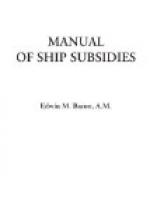While the fundamental rules of the “Maritime Charter” of 1660 remained practically unimpaired, although in the succeeding years hundreds of regulating statutes were passed, breaks were made in the restrictive barriers of the code during the first third of the nineteenth century by the adoption of the principle of maritime reciprocity.[N] In 1815 (July 3) a convention establishing a “reciprocal liberty of commerce,” between the “territories of Great Britain in Europe and those of the United States,” was signed in London.[O] In 1824-1826 reciprocity treaties were entered into with various continental powers. In 1827 (August 6) the treaty of 1815 with the United States was renewed. In 1830 a treaty for regulating the commercial intercourse between the British colonial possessions and the United States was executed.[P] Under these conventions, repeatedly interrupted by British Orders in Council and by Presidents’ proclamations,[Q] the trading intercourse between both countries was regulated till the abrogation of the code of 1660.
In 1844 an indirect move against the code was made, with the appointment of a committee of the House of Commons to inquire into the working of the reciprocal treaties and the condition of the mercantile marine of the country.[R]
At this period the competition of the United States in the overseas carrying trade of the world was hard pressing England. The Americans were building the best wooden ships, superior in model and seaworthiness, the fastest sailers. They were leading in shipbuilding. Much of the British shipping trade was carried on in American-built vessels. The splendid American clipper ships were almost monopolizing the carrying trade between Great Britain and the United States. Most of the shipping of the world was yet in wooden bottoms. Iron ships were in service, but iron-shipbuilding was in its infancy.
The Parliamentary inquiry of 1844 was followed up in 1847 with a move openly against the ancient code. Its principles as they then stood, essentially as in 1660, despite the multitude of regulating statutes, are thus enumerated:
1. Certain named articles of European produce could only be imported into the United Kingdom for consumption in British ships, or in ships of the country of which the goods were the produce, or of the country from which they were usually imported.
2. No produce of Asia, Africa, or America could be imported for consumption into the United Kingdom from Europe in any ships; and such produce could only be imported from any other place in British ships, or in ships of the country of which the goods were the produce and from which they were usually imported.
3. No goods could
be carried coastwise from one part of the
United Kingdom to another
in any but British ships.
4. No goods could
be exported from the United Kingdom to any of
the British possessions
in Asia, Africa, or America (with some
exceptions with regard
to India) in any but British ships.




